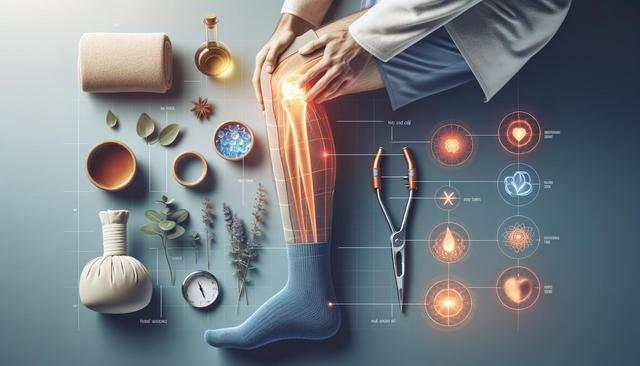Common Causes of Leg Pain
Leg pain can result from a variety of conditions, ranging from muscle fatigue to more complex vascular issues. One overlooked cause is poor blood circulation, which can significantly affect the legs’ ability to function normally. Symptoms like numbness in legs and feet, cramping, or a heavy sensation while walking can be early indicators of circulation problems. In some cases, people may also experience cold feet and toes. This discomfort is often misattributed to external temperature rather than an internal vascular issue.
Conditions such as peripheral artery disease (PAD), diabetes, or even prolonged inactivity can contribute to poor circulation in legs. When blood flow is restricted, it deprives the lower limbs of essential oxygen and nutrients, leading to pain, fatigue, and in severe cases, tissue damage. Recognizing these symptoms early can help in preventing further complications and determining the right course of treatment.
Recognizing Signs of Poor Circulation
Identifying the signs of poor circulation in legs is crucial for timely treatment. Poor circulation often manifests subtly, but the signs become more evident over time. Being aware of these can prompt individuals to seek medical assistance before the condition worsens.
Common signs include:
- Persistent leg pain during walking or exercise (claudication)
- Discoloration in the lower legs or feet
- Foot pain due to poor circulation, especially while resting
- Slow-healing wounds on the lower limbs
- Cold feet and toes, even in warm environments
If any of these symptoms are present, it may be time to consult a specialist or a vascular clinic for leg pain. These clinics can perform diagnostic tests like Doppler ultrasounds or ankle-brachial index (ABI) measurements to evaluate blood flow and determine the severity of vascular impairment.
Treatment Options for Circulation-Related Leg Pain
Treating leg pain rooted in vascular issues typically involves a combination of lifestyle changes, medication, and sometimes medical procedures. The first step is usually addressing the underlying cause of the poor circulation in legs. This might include managing conditions like diabetes, hypertension, or high cholesterol.
Some commonly recommended treatments include:
- Regular, moderate exercise such as walking to promote blood flow
- Dietary changes to reduce plaque buildup in arteries
- Medications that improve circulation or reduce blood clot risks
- Compression stockings to support venous return
- In more severe cases, angioplasty or surgery to restore proper blood flow
By targeting the root cause, these treatments can relieve symptoms like numbness in legs and feet and improve overall limb function. Working with vascular specialists ensures a personalized approach that addresses each individual’s health profile.
When to Visit a Vascular Clinic
It’s advisable to visit a vascular clinic for leg pain when symptoms persist despite home remedies or lifestyle changes. These clinics are equipped to handle complex circulation issues and can offer targeted treatments that general practitioners may not provide. If you’re experiencing foot pain due to poor circulation or consistent cold feet and toes, a vascular assessment can help determine whether your symptoms stem from arterial or venous problems.
At a vascular clinic, patients can expect:
- Comprehensive vascular assessments
- Diagnostic imaging to assess blood flow
- Personalized treatment plans including lifestyle, pharmaceutical, and procedural options
- Ongoing monitoring to track improvements or adjust care
Early diagnosis and intervention can prevent complications and improve quality of life. The sooner circulation issues are addressed, the better the outcome for managing leg pain effectively.
Preventing Leg Pain Through Healthy Habits
Prevention is often the most effective approach to managing leg pain, especially when vascular health is a concern. Incorporating healthy habits into your daily routine can significantly reduce the risk of developing poor circulation in legs. These practices not only support vascular health but also contribute to overall well-being.
Key preventive strategies include:
- Staying active with low-impact exercises like walking or swimming
- Maintaining a balanced diet rich in fruits, vegetables, and whole grains
- Avoiding tobacco use, which is a major risk factor for vascular disease
- Managing blood pressure, cholesterol, and blood sugar levels
- Wearing properly fitted footwear to avoid undue pressure on the feet
Monitoring for early signs of poor circulation in legs and seeking medical advice when symptoms arise can help prevent more serious complications. Even subtle signs like numbness in legs and feet or persistent cold feet and toes should not be ignored, as they may indicate early stages of vascular issues.
Conclusion
Leg pain can be more than just a temporary discomfort—it may signal underlying issues like poor circulation in legs. Recognizing symptoms such as numbness in legs and feet, cold feet and toes, and foot pain due to poor circulation is essential for early intervention. Visiting a vascular clinic for leg pain can lead to accurate diagnosis and effective treatment plans. By adopting healthy habits and staying vigilant about vascular health, individuals can manage and even prevent circulation-related leg pain, leading to a more active and pain-free lifestyle.




Leave a Reply